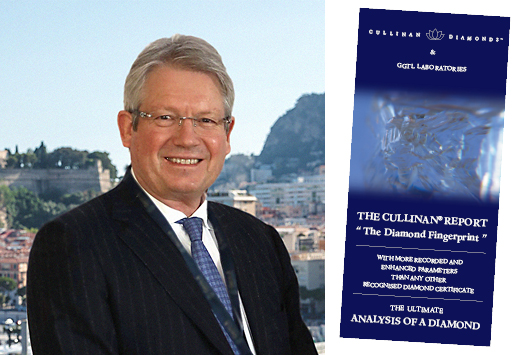 Image: Cullinan Diamonds
Image: Cullinan Diamonds
Diamonds get stolen, swapped and recut, all dramatic situations for owners of precious gems. However, by identifying a stone’s unique fingerprint and having it recorded on a specific certificate, it is possible to protect valuable diamonds.
This is the attractive offering from the Cullinan Diamond Report (“Cullinan Report”), which Cullinan Diamonds developed in collaboration with Dr. Thomas Hainschwang from the Liechtenstein-based GGTL Laboratories.
With a family history deeply rooted in diamond prospecting and exploration, Cullinan Diamonds has “a privileged point of view in observing the particular aspects that concern the security, safety and credibility of a stone in the industry and to the eventual customer,” says the company’s CEO, Mark Cullinan.
Link in the blockchain
Even with consumers asking for greater transparency, and even though the industry has made many noteworthy efforts to guarantee that the origins of diamonds are known, there are still some notable pitfalls. The trade needs to question whether its current methods and checks are sufficient, Cullinan says. “The diamond industry does its best to try and verify the stones through the Kimberley Process (KP), but the KP is not necessarily foolproof.”
And while he praises the benefits of blockchain as a guarantee in a chain of certification, Cullinan also points out the limitations when it comes to matching a diamond to a particular certificate. “What is not verified is that the diamond you are holding with the certificate is actually the diamond that relates to that certificate,” he explains.
What the Cullinan Report purports to offer is “the highest standard possible, providing every parameter necessary to establish the unique identification of a stone,” Cullinan states. Behind the report are Dr. Hainschwang’s years of research and expertise. These techniques include IR spectroscopy, UV-Vis-NIR spectroscopy, diamond fluorescence imaging, and a number of techniques proprietorial to the GGTL Laboratories.
This thorough analysis takes four times longer than mainstream diamond-grading methods and leaves “absolutely no room for doubt,” says Cullinan. The additional analysis makes it most suitable for stones above 2 to 3 carats and valuable colored diamonds.
Among other benefits, the procedure links the polished diamonds to their original rough stone, if it was analyzed prior to cutting.
Added value
Knowing their stone will be traceable also gives diamond owners peace of mind. A client who entrusts his or her diamond jewelry to a jeweler for repair, for instance, can say the diamond has a certificate that shows its unique characteristics, Cullinan points out. That can act as a powerful deterrent against replacing stones. This defense applies to dealers who are selling on memo or attending trade fairs, too.
Another important purpose of the Cullinan Diamond Report is verifying the identity of diamonds that are registered in a diamond fund.
“There have been diamond funds in the past, notably colored diamonds, where there has been some verification needed of the diamonds going in and out of the fund,” explains Cullinan. “For example, which diamonds are being bought and sold into the fund. This has necessitated a person to act as an authority or arbitrator, in addition to the requirement for an independent audit of the stock.”
Reserved for the most important diamond transactions, the Cullinan Report is a tool that provides professional and private collectors with the safest possible identification of their stones to guarantee their investment.
For more information, visit
ggtl-lab.org and
cullinandiamonds.comArticle from the Rapaport Magazine - January 2022. To subscribe click here.